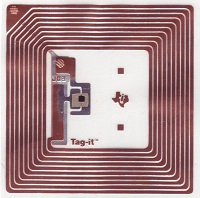How An RFID System Works
by Black Ink Team
RFID stands for radio-frequency identification. The technology consists of two parts: ‘tags’ and ‘scanners.’ Tags are microchips that get embedded in objects and contain information relating to the objects they get embedded in. Scanners are handheld or fixed-location devices that read the information contained in RFID tags.
There are two varieties of RFID tags: ‘active’ and ‘passive.’ Active tags are equipped with batteries that allow them to transmit data continuously over far distances. Passive tags have no internal battery source and have a small effective range, compared to active tags. When a scanner reads a passive tag, it emits electromagnetic waves that power the tag to let it broadcast its data.
When a tag gets read by a scanner, a change must be made in a database – otherwise no data exchange has been made. An example would be a shipment of products that have RFID tags being received, scanned, and marked as ‘received’ in a database.

An RFID tag made by Texas Instruments
Depending on the requirements for the RFID system that is needed, the cost can vary. If the tag can safely go on the outside of an object, and you don’t need to constantly track where that object is, then a basic passive RFID tag would suffice – 10 cents each. If the tag must go inside the object and the object is made out of a dense substance, for instance metal, then a more capable passive RFID tag is needed - $1 each. If you want to track objects and see where they move in real-time, then an active system with active tags will be necessary - $15-$20 each. Handheld scanners for passive tags go for a couple thousand dollars; when dealing with fixed-position passive RFID scanners you have to factor in installation fees, which can translate to the whole reading system costing upwards of $10,000. Active RFID tag-reading systems aren’t much more expensive than passive RFID scanners, but the installation process and the software to use them are significantly more complicated.
RFID tags and scanners are superior in many ways to traditional bar codes. For one thing, printed bar codes that one must scan can be scuffed or torn off during transit, making a mess for the distributor or dealer who receives the item to deal with. Additionally, RFID tags can be encrypted so that only people with company-issued scanners can see what a boxed object is and where it came from. RFID makes item handling faster and safer.
